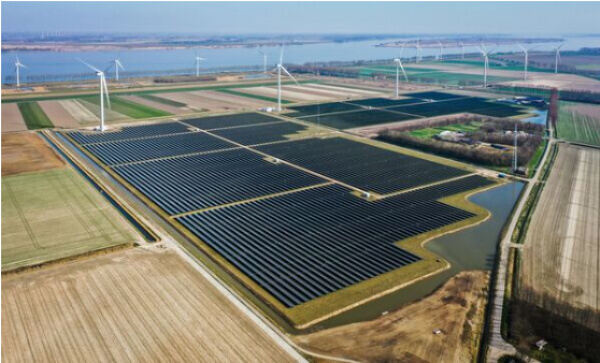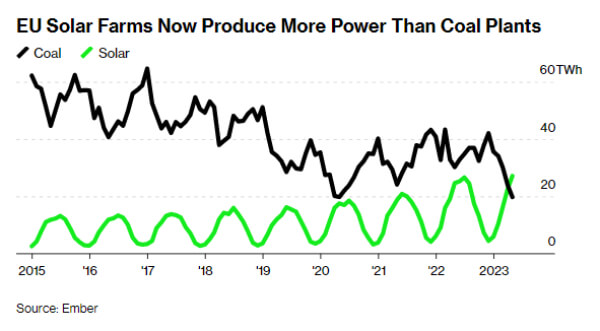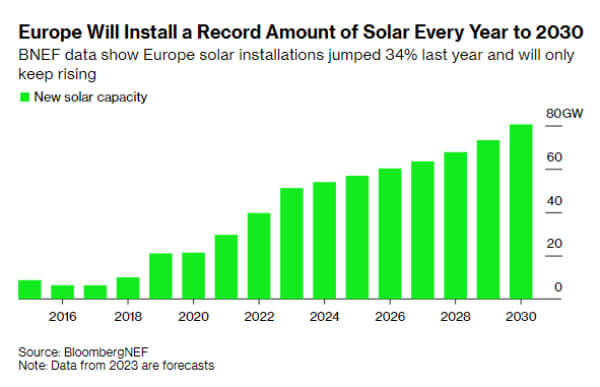Latest milestone! European solar power generation exceeds coal power for the first time
 namkoo solar
namkoo solar

The Netherlands has more than 100 megawatts of solar power capacity per 100,000 inhabitants
A milestone event in the EU's clean energy transition occurred in May 2023, when solar power generated more electricity than all coal-fired plants in the EU for the first time - and that was before the summer sun pushed up power generation even further.
While the surge in solar power generation benefits efforts to replace fossil fuels, the breakthrough also exposes flaws in the energy system. On some of the sunniest days in May, electricity prices fell into negative territory at one point as grid operators were overwhelmed by the power surge.
For this summer, we will have to look at it as something on a postcard from the future," said Kesavarthiniy Savarimuthu, an analyst with Bloomberg New Energy Finance. The most important message will be: we are not ready for this."

EU solar power generation now higher than coal-fired generation
While solar power is a quick solution to the energy crisis triggered by Russia's restrictions on natural gas supplies last year, there is a downside in that the technology performs best during sunny months, when electricity demand is at a low level. Systems that store that electricity in batteries or use it to make green hydrogen are not yet advanced enough to allow the summer sun to provide lighting at night and heating for homes in winter.
The Netherlands has the world's densest solar power network
Nowhere is the solar boom and its risk of adjustment more evident than in the Netherlands. In the Netherlands, there is more than 100 megawatts of solar power capacity per 100,000 inhabitants, twice as much as in sunny Spain and more than three times as much as in China - which as of today has the world's highest overall solar power capacity.
The Netherlands has the densest solar power network in the world, thanks in large part to long-term government support. The government's incentive program is open to all households that install solar panels, and every watt of electricity generated offsets an energy bill, regardless of whether electricity use matches the amount of electricity generated during the sunniest part of the day.
Jorrit de Jong, a spokesman for Dutch grid operator TenneT, said, "The Dutch government did this to encourage the installation of solar panels, but it was a bit too successful." He has seven rooftop solar panels that address at least 80 percent of his family's annual electricity use. "Doing laundry or charging my car when there's no sunlight doesn't affect me because it's paid for by my energy company."
The Dutch government intends to change this system from 2025. Under the new rules, households that send electricity back to the grid will see a gradual reduction in the amount of electricity deducted from their annual energy bills. By 2031, households that generate electricity will only benefit from it if they actually use it, and will not receive any compensation for the amount they use in excess.
Europe expects to decarbonize grid by 2035
The whole of Europe is following the lead of the Netherlands. Solar panel installations in the EU have accelerated since the Russia-Ukraine conflict. in May 2023, electricity generation increased by 10 percent over the same period the previous year to a record 27 terawatt hours.
An important advantage of solar power over wind, hydro or geothermal power is the speed of installation. All that needs to be done is to encourage homeowners or real estate companies to turn their rooftops into mini energy parks. But the grid is built around large generators that work in concert with the grid operator in order to keep the network balanced. A distributed PV system is more difficult to manage and will be tested in earnest in the summer of 2023.
While record solar and wind generation in 2023 has helped phase out some coal- and gas-fired power plants at an impressive rate, the EU's goal of net zero emissions by 2050 is still a long way off. Germany in particular is under enormous pressure, with Europe's largest electricity market aiming to decarbonize its grid by 2035. To do this, it is important not only to vigorously develop clean energy, but also to make changes to better integrate the use of electricity with power generation.

Europe to add a record amount of solar power capacity every year until 2030
A mismatch between supply and demand is already showing signs. Over the weekend, electricity prices fell into negative territory from time to time as Germany, Europe's largest solar power producer, reached new highs in solar power generation. Negative electricity prices are not unheard of and are usually associated with sparse demand for electricity at night or on weekends while wind power is more abundant.
When electricity surges, suppliers must pay consumers for the electricity they use. This does not mean that 100% of the electricity comes from renewable sources. Some conventional power plants do not have the flexibility to switch their generation on and off, or need to maintain grid stability through normal operation.
Axel Thiemann, CEO of Sonnedix, one of Europe's largest solar power producers, said that increased volatility in electricity prices and persistently low or even negative tariffs during peak renewable generation periods could put future investments at risk.
The number of pipelines for Sonnedix's European projects has roughly doubled since the end of 2021, but Thiemann warned that development will be more difficult if the way power is managed does not change.
As more investment is seen, the grid will become increasingly saturated at certain times of the day in the summer," he said in an interview. Even if an unlimited number of solar projects are approved, they won't be built unless there's a clear route to market."
To respond more effectively to fluctuations in renewable energy generation, the power system needs a new kind of flexibility. Such flexibility is not needed when all the electricity comes from a few huge fossil-fueled power plants and nuclear power plants, which can regulate generation according to the demand for electricity.
"Our current power system does not plan for this flexibility in electricity demand," says Thorsten Lenck, project manager at Berlin-based think tank Agora Energiewende.
There are multiple ways to adapt. Batteries connected to the grid could use power when the sun is at its peak or the wind is at its strongest during the day, and sell electricity when renewables are under-generated. Consumers can also be encouraged to use electricity during peak generation times. This is especially important as electric vehicle ownership increases and homes switch from using conventional boilers to heat pumps.
This summer, we will have unprecedented levels of solar power, which typically increases the volatility of electricity prices," said Joke Steinwart, an analyst at research firm Aurora Energy Research. There will be huge opportunities for flexible technologies such as batteries."



































